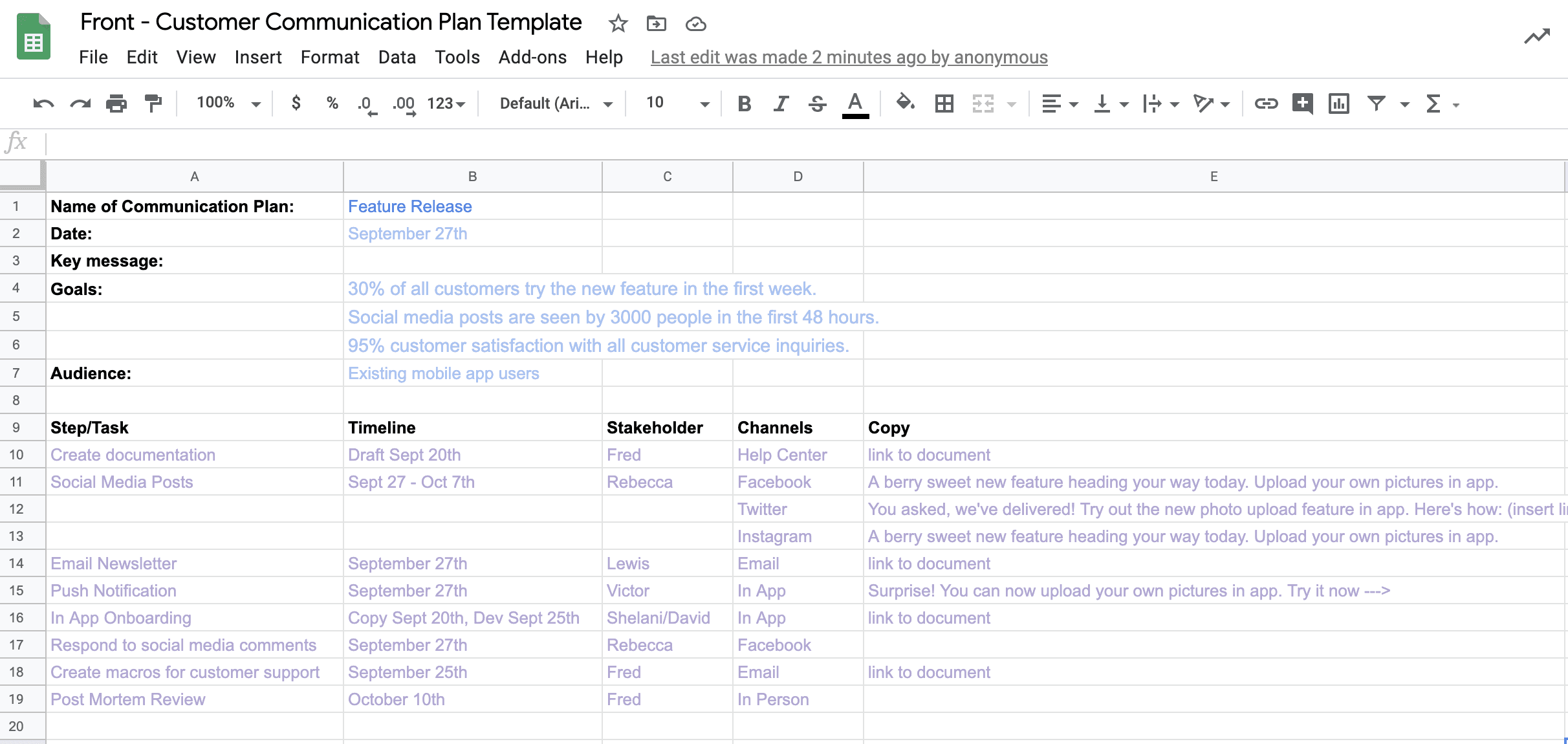Failure to plan is planning to fail.
Now that we’ve got the fatherly advice out of the way, it’s time to talk about creating a customer communication plan.
It might seem like a more corporate practice, but putting a customer communication plan in place can help you increase customer engagement and cut down on support messages. Even if you communicate openly with customers through daily conversations, a customer communication plan can make your efforts more effective.
Below we’ve detailed a plan to create your own customer communication plan. The key here? It needs to span across departments. Yes, your customer success team and support teams might be the ones communicating with customers regularly, but they’re not the only ones whose jobs impact customers. Operations, sales, marketing, product, finance — they all play a critical role in your customer communication plan. And, since getting started is always half the battle, at the bottom, we’ve provided a free template that will help you get started.
What is a cross-departmental customer communication plan?
A customer communication communication plan is a detailed document that outlines the messages you need to deliver, the people who need to receive and understand those messages, and the internal stakeholders (across teams in your business) who are accountable for each step. This information empowers your organization to act quickly to share the right information with customers. While cross-departmental customer communication plans can be helpful in, for instance, a customer service crisis, they are also helpful for product launches, promotions, or other external events.
Why is developing a customer communication plan important for teams?
Planning and acting require two different parts of the brain. Taking the time to thoughtfully plan what you want to say before jumping into action reduces the risks of communicating poorly or forgetting something important.
Besides, you don’t want to spend time in detailed planning sessions when everything is already chaotic, such as during a crisis or a product release. Having a plan already in place allows you to take action immediately. Everyone will be clear on their individual roles and responsibilities, which allows everyone to manage their own time.
Having a customer communication plan also ensures consistency across the organization. Customers will hear the same response whether they are reading your email, speaking with your support team, or following you on social media.
Finally, having a written plan makes it possible to reflect back on what worked and what didn’t. After the event is over, compare your expected results with what happened and make incremental improvements to improve customer communication in the future.
How to develop a customer communication plan
1. Review the materials you already have available
The first step in any journey is understanding where you’re starting from. It’s the “You are here” star on your hiking trail map (or shopping mall map, your choice!) By taking stock of the resources already available to you, you avoid extra work. Plus, it helps to make sure you’re covering all the bases and involving all the people that need to have a say. Questions to ask yourself include;
What documentation already exists?
What channels do you already communicate over?
What departments or employees can help? (ie. social media teams, branding, email marketing, etc)
What assets do you have available to use?
Where are your branding and style and tone guidelines kept?
2. Identify the purpose of your communications
Summarize the overarching key purpose of your communication plan. What message do you want to communicate to your audience? What actions do you want them to take? Understanding the purpose of your communications will guide how you plan and execute.
For example, imagine you’re communicating a new feature release to customers. Some goals that you might set for yourself include:
30% of all customers try the new feature in the first week.
Social media posts are seen by 3000 people in the first 48 hours.
95% customer satisfaction with all customer service inquiries.
3. Define your audience
You may already have a target audience for your marketing or product campaigns. But for each specific customer communication plan, you’ll want to further refine it. Are you targeting active users? Is the feature available for all plan types? Are leads and prospects included in the audience?
Who you choose to target will help to refine your messaging as well as the channels you choose to communicate over.
4. Outline your plan with timelines and communication channels
Create a document that outlines the series of steps and tasks required. What needs to happen in order for you to complete your goals?
For each task, identify when it needs to be completed and on which channel. For a crisis communication plan, you may want to assign someone to post updates to the status page every 30 minutes. For a feature release, perhaps you only need to publish one Facebook post on the day of the release.
5. Assign team members on specific parts of the plan
Each functional area will have their own responsibilities. But if you don’t write it down, things can slip through the cracks. By making someone accountable for each task on your communication plan ahead of time, you can be confident it will get done on time.
Team members and stakeholders to include:
Customer Support for client communication and documentation
Marketing for branding, social media, website updates, and email newsletters
Development/Product for any in-app updates or status page updates
PR for any press releases or media requests
6. Complete tasks and draft messaging for the team
Once you’ve created your communication plan, it’s time to create or gather any resources that your team requires. Each task owner will need to prepare any documents that are required, such as prepping documentation, social media posts, and email newsletters.
For customer support teams, creating message templates (you can do this easily in Front!) that have already been approved by the communications team can make things much easier. Customers will receive consistent answers, and agents will be able to respond quickly to incoming questions.
Bonus: Measure your results and share customer feedback internally
Once you’ve completed your communication plan, consider reviewing how everything went. Did you achieve your goals? Did your customers provide feedback or have questions you didn’t anticipate?
A post-mortem meeting to gather stakeholders together can uncover a wealth of insight into what each team can be doing better. And don’t forget to share that feedback among the team internally. The next time you need to communicate something important to your customers, you will be even more prepared than you were this time.
Customer Communication Plan Template
We want to help you put it all your customer communications together in one easy place (which is why we built...Front). But in case you’re not using Front, you can use this template to plan out your next customer communication strategy and make that next crisis, release, or PR event go as smoothly as possible.

Written by Sarah Chambers
Originally Published: 28 August 2020











